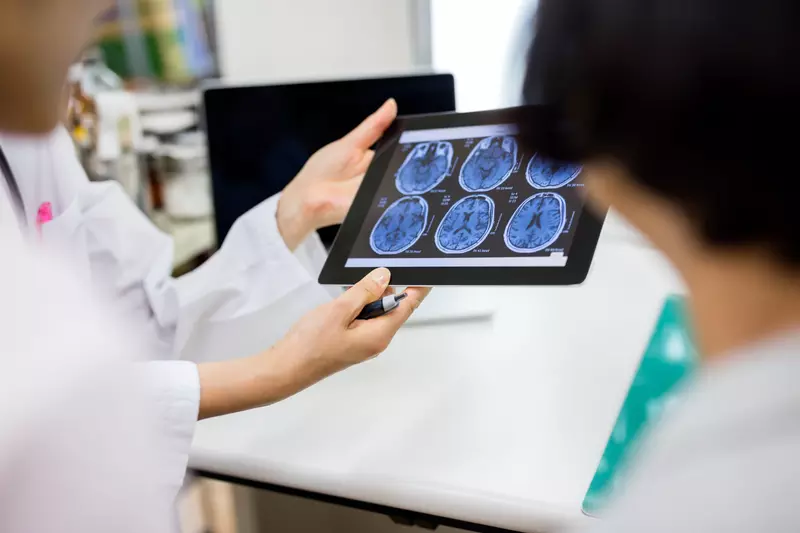
World-Class Care in Steady Hands
Your brain is one of the most important and interconnected parts of your body. So, it only makes sense to find a care team with renowned expertise in a variety of specialties — all working together to help you regain control of your body and your life.
At the AdventHealth Neuroscience Institute, our team of trusted physicians and specialists in deep brain stimulation is ready to help you or a loved one regain control and feel like yourself again.
What to Know About Deep Brain Stimulation
- What Is Deep Brain Stimulation?
-
Your nervous system (which includes your brain and spinal cord) allows you to feel, communicate and move around. But in some instances, your nervous system may become impaired through injury, infection or from medication side effects. Severe impairment can lead to movement disorders that cause uncontrolled physical movement or tics. Medication can be helpful, but sometimes, it’s not enough.
Deep brain stimulation is a surgical procedure that helps you regain movement control with advanced technology carefully implanted under your skin near your chest that speaks to your brain. In this procedure, your surgeon will gently enter your skull and insert electrical conductors called electrodes that send impulses throughout your body. These impulses impact your abnormal nerves and help how you move.
The pacemaker-like device implanted near your chest controls the electrodes and is programmed by your surgeon. Deep brain stimulation has proven so effective that many people who undergo the procedure to correct their movement no longer need daily medication.
This is a highly effective and advanced procedure that involves an expertly trained group of providers across many specialties. Your care team will consist of a neurologist, neurosurgeon, physical therapist, speech-language pathologist and a social worker who can help tend to your unique needs. - What Conditions Does It Treat?
-
Deep brain stimulation is helpful in treating a variety of movement disorders, like:
Dystonia
This is a condition that makes your muscles contract, twist or repeat movements throughout your body, often affecting your neck or hand control. Dystonia can be mistaken for a seizure, but there is no loss of consciousness. Deep brain stimulation isn’t always a quick fix for people with dystonia. Some do not see a response until a year after surgery.
Essential Tremor
Essential tremor is usually a result of a genetic mutation. It happens when your nervous system no longer has proper control of your body, causing you to shake. Essential tremor can affect your head or voice but most often affects your hands.
Parkinson’s Disease
This is a condition that can cause shakiness or stiffness, among other symptoms. Over time, this disease tends to become more severe, and can advance into difficulty with walking and speaking.
If you have Parkinson’s, deep brain stimulation can help with movement control and speed. However, it does not fix non-movement-related Parkinson’s symptoms, like mood, memory and trouble sleeping.
In addition to helping with movement control, deep brain stimulation is also used to treat addiction, depression, stroke and traumatic brain injury.
- What Types Are There?
-
Unlike many surgical procedures where you’d be under anesthesia, brain surgery can be especially effective if you are awake for some of it. Your neurologists and neurosurgeons will recommend “asleep” or “awake” deep brain stimulation, based on your unique needs.
“Asleep” Deep Brain Stimulation
While you’re under general anesthesia, your surgeon will use imaging techniques like computerized tomography (CT) or magnetic resonance imaging (MRI) as a guide to insert electrodes into your brain. This type of procedure may be an option if you have symptoms that are controlled only by medication, or if you’re anxious about being awake during surgery.
“Awake” Deep Brain Stimulation
In some cases, you benefit most when you’re awake for the procedure. Images from a computerized tomography (CT) scan guide your surgeon inside your skull. A specialist will administer anesthesia to ensure you’re comfortable and don’t feel anything but are alert enough to answer questions. This interaction helps your surgeon identify where to place the electrodes.
Informed, Connected Care
To qualify for deep brain stimulation, you’ll be evaluated by experts from several specialties related to movement disorders.
-
Movement Disorder Neurology
An “ON-OFF” evaluation helps us record how much a patient with Parkinson’s disease can control their motor functioning when their medication wears off.
-
Neurology and Imaging
Our neurology and imaging technicians will perform a magnetic resonance imaging (MRI) test on your skull, which allows us to clearly visualize your brain.
-
Neuropsychology
Testing your memory and language skills while you’re on medication helps us identify and prepare for any risk factors that may result from surgery. Testing takes around four hours.
-
Neurosurgery
We’ll help you decide which surgery, if any, is right for you.
-
Physical and Occupational Therapy
Our physical and occupational therapists will observe your motor skills and evaluate how you perform everyday activities.
-
Speech-Language Pathology
Based on your condition and your personal needs, you may be referred to a speech-language pathologist who will assess your oral proficiency before your procedure.
Performing Surgery for the Entertainer
A professional ventriloquist, Mark Wade relied on his voice tricks and puppet control to make people laugh. When his movement disorder started to interfere with his performance, Mark sought our help.

Brain Stimulation Care Every Step of the Way
When you’re planning for deep brain stimulation, you meet a lot of specialists and schedule a lot of appointments. That’s why we’re making it easier to navigate this journey with a dedicated care team that will assist with the details.


